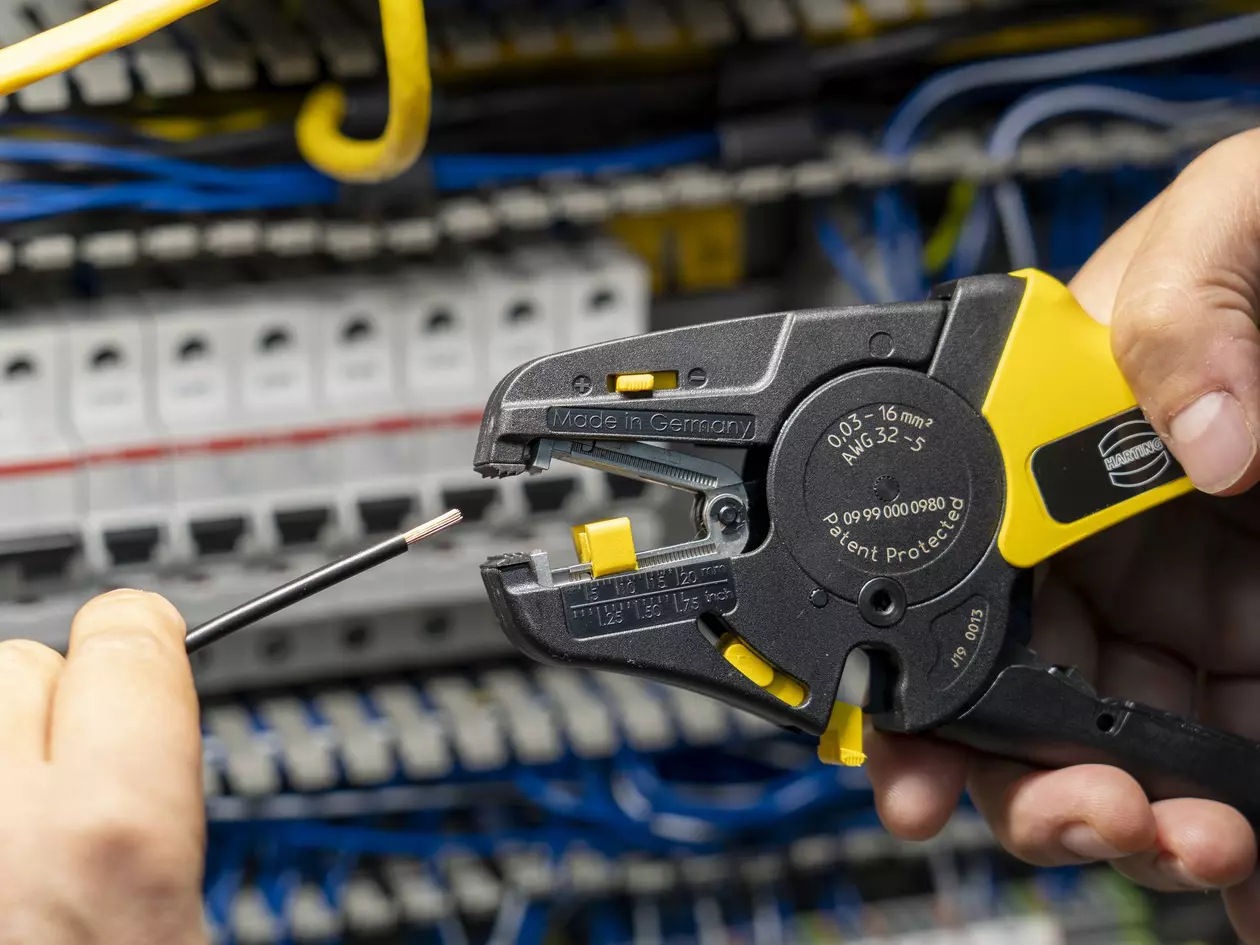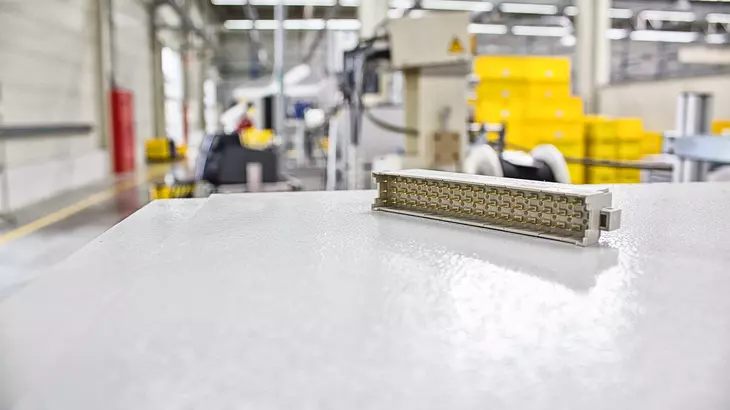Knowledge about tools
Cutting / Stripping

Tips and tricks for cutting / stripping
A high quality connection is essential for generating installation applications. The first step is to cut and strip the cable.
The natural twisting of the cable should be retained.
Even during cable processing, it is essential to optimise and monitor the stripping and cutting process.
No strands should be crushed, cut or protruding.
The insulation should be undamaged and must not be excessively damaged or torn off so that the insulation does not impair the application.
Advantages of cutting / stripping
With our cutting and stripping tools, you have the best way to prepare your cables or your installation environment for further processing with a straight and crimp-free cut.
Your advantages:
Simple operation for clean cutting
Little effort for unlimited power
Ergonomic and high-quality handling for long working hours


HARTING cutting and stripping tools
Ergonomic handling for long working periods
Multifunctional stripping tool from 0.03 mm2 to 16 mm2 with replaceable blades
HARTING punching tools for panel feed throughs
Hand-operated hydraulic or battery-powered tools are a good solution for punching panel feed throughs for HARTING hoods/housings when constructing a control cabinet.

Crimping

There are three important aspects to consider in the crimping process. In addition to choosing between the contact and cable, the correct use of the recommended crimping tool is essential. With the crimping tools from HARTING, we offer you a range of solutions for processing HARTING contacts to your requirements. For example, all our tools meet the requirements set out in DIN EN 60352-2. You can find more information here on the advantages and the correct test procedures for the crimping process.
Advantages of crimp technology
Gas-tightness: The components are pressed together so strongly that there are no gaps: This means that neither liquids nor gases can penetrate the contact point.
Consistent crimp quality: High reproducibility thanks to the use of professional crimping tools
Speed: Higher wiring speed compared to other termination techniques
Largely automatable: Easier prefabrication of cable harnesses and interfaces
Compact: Higher contact density can be achieved compared to other termination techniques
Tips and tricks for crimping
With the right knowledge and the right tools, crimping is a simple and precise termination technique. Crimping starts with correctly cutting the conductor. A successful first step in a crimping process is a clean, straight and crimp-free cut. The insulation should then be removed without damaging the conductor. How much insulation is stripped away depends on the kind of contact. After preparing the conductor, the conductor end can be crimped to the intended contact or wire ferrule using HARTING tools.
Hand crimping tools
For loose, turned and punched male and female contacts from 0.08 mm² to 10 mm² cable diameter
For punched contacts on a strip
For wire ferrules from 0.14 mm² to 16 mm²
A broad portfolio of hand crimping tools for processing a versatile range of contacts
Various crimping technologies
Tested and approved according to DIN EN 60352-2
Ergonomic grips for every application


Power-assisted crimping tools
For loose, turned male and female contacts from 0.14 mm² to 240 mm² cable diameter
Optimised for medium contact volumes
A broad portfolio of hand crimping tools for a wide portfolio of contacts
Various crimping technologies for every application
Recommended for entry-level stationary industrial use and for power-assisted applications
Crimping machines
For turned loose male and female crimp contacts without conversion
For punched contacts on a strip
Automatic contact feed and separation
Simply set the stripping length and crimping depths
Tested crimp quality to DIN EN 60352-2 based on the 4-arbor double notch mechanism
Recommended for stationary industrial use
Optimised for high production volumes

Press-in

Discover the world of solderless connection technology with our press-in technology. This innovative method uses modern, deformable elastic press-in zones to compensate for tolerances and meet high electrical and mechanical requirements. Ideal for selectively gold-plated connector pins, this technology offers an efficient and economical solution for your connection needs.
Advantages of press-in technology
Thermal shocks caused by the soldering process and the associated risk of PCB failure are avoided.
Subsequent cleaning of the populated circuit boards is no longer necessary.
Additional wrapped connections are possible by using connectors with long connector pins.
Unlimited economical processing of selectively gold-plated connector pins for rearward transfer systems - no more hand soldering required!
Tips and tricks for press-in technology
The press-in process must be done vertically. The upper and lower tools must be precisely aligned with each other and the press-in process must be as continuous as possible.
We have developed all the necessary devices and tools specifically for press-in technology, distinguishing between press-in connectors - DIN Signal and DIN Power (2.54 mm pitch) and press-in connectors - har-bus® HM (2.00 mm pitch).
Our press-in tools for DIN Signal / Power are characterised by their precise design. The upper tools are flat and provide holding or guiding elements as needed, while the lower tools effectively support the PCB and through-hole plating. The press-in process is effortless thanks to our simple holding and positioning system. Our inserts also enable cost-efficient processing of DIN Signal male connectors.
Press-in tools for DIN Signal / Power
Upper tools
Press-in tools for press-in connectors - DIN Signal / DIN Power.
The upper tool is usually flat and even or has holding or guiding parts, depending on requirements.


Lower tools
The lower tools support the PCB and, if possible, the through-hole plating. This safely absorbs the forces that occur and protects the printed circuit board. The lower tools are usually designed as a comb, as this simplifies the positioning of the PCB.
Fixtures
These tools can now be held in the fixtures using a simple holding and positioning system. Once aligned, they can be pressed in easily.


Plastic insert tools
Inserts are available for the DIN Signal contact carrier for press-in connectors that enable these connectors to be connected with a simple flat press-in connector. These are cost-effective and efficient.
Press-in tools for har-bus® HM
Modular system for har-bus® HM
Press-in tools for press-in connectors of the har-bus® HM type are available as a modular system.
The upper and lower tools are selected to fit the application and moved into the appropriate position.
The PICMG Standard is decisive for positioning.


Plastic with metal plate insert tool
As there is now an incredible number of applications, HARTING has developed a unique tool for power users: the insert. This means that all contact carriers can be processed easily and efficiently with the matching insert and a flat upper tool. The lower tool for this is then created by the user.
The advantages: fast - efficient - cost-effective - sustainable.
Fixtures
These tools can now be held in the fixtures using a simple holding and positioning system. Once aligned, they can be pressed in easily.


Repair tools for press-in technology
One advantage of press-in technology is that it is easy to repair. Individual contacts can be repaired, for example, if a pin has been bent. However, it is also possible to press entire press-in connectors out of the PCB again.
It is also possible to simply remove termination supports or straighten contacts.
Disassembly/assembly
Installation and removal tools
HARTING offers a comprehensive portfolio of tools for all essential termination techniques and assembly steps. With the tools from HARTING, you can complete your work step faster, more flexibly and more precisely than ever before, enabling you to complete even demanding assembly steps effortlessly and force-free.
Your advantages:
Optimum coordination between tools and components, even in precise applications
Quick and easy use of the disassembly/assembly tools saves time
Non-destructive installation of components
Ensuring correct function in your application


Assembly
For assembly of HARTING components
To support correct installation
For inserting contacts
Ergonomic designs
Designed for the most precise requirements
Disassembly
For removal of HARTING components
To support the correct final installation
For disassembly of contacts
Ease of handling
Ergonomic design
Designed for the most precise requirements



